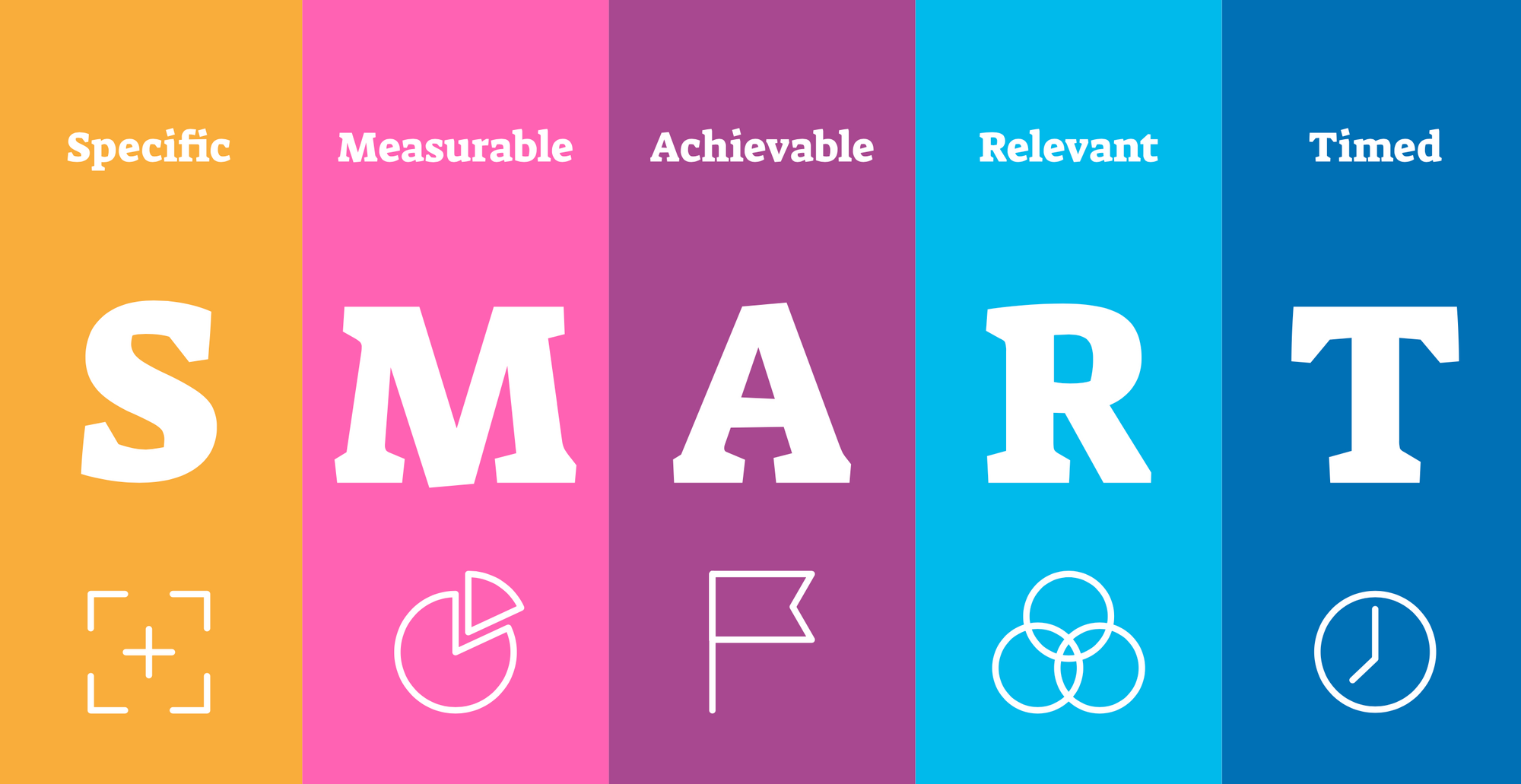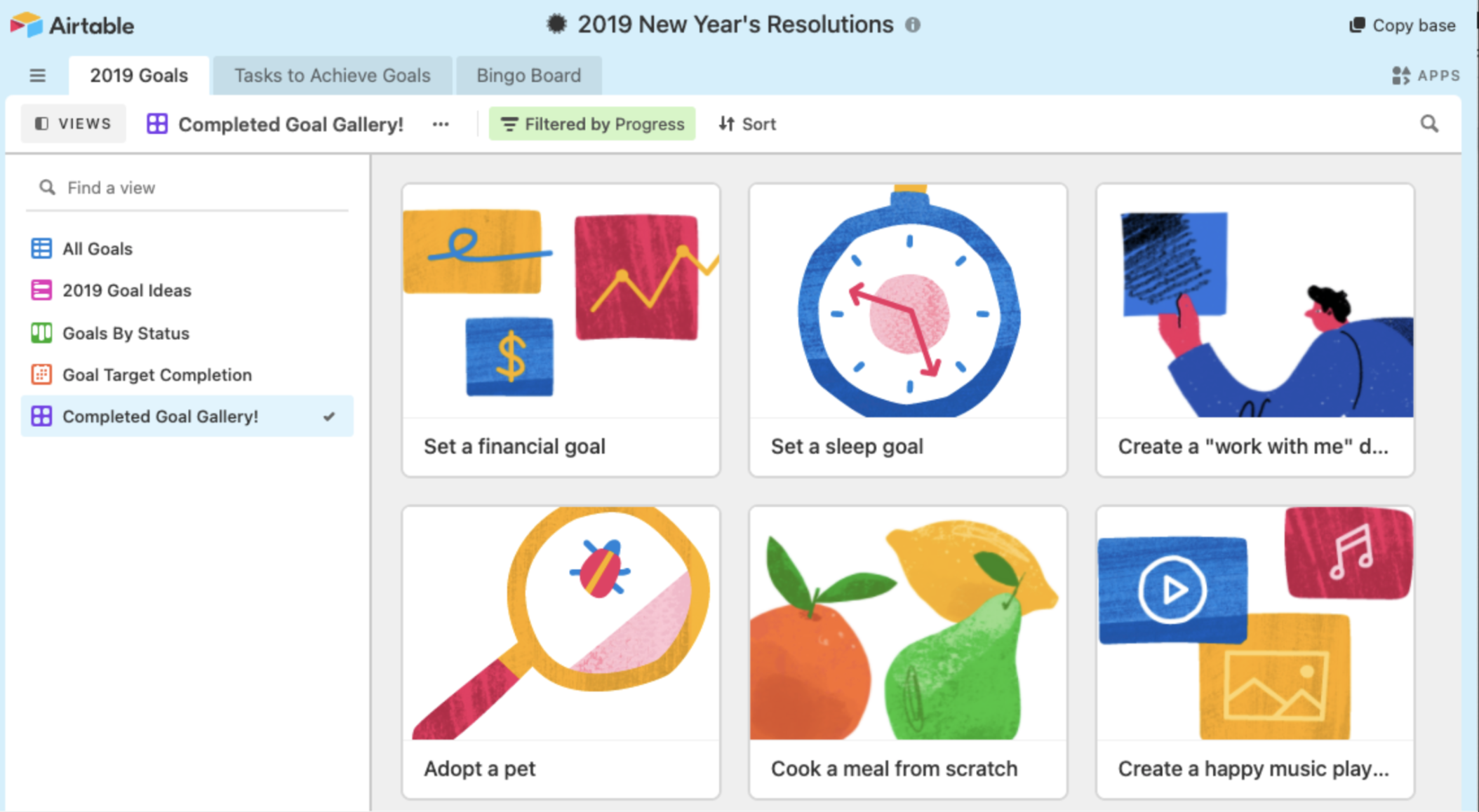Not all approaches to goal-setting are created equal. Or SMART, for that matter. (And for once, “smart” doesn’t have anything to do with your smart TV, smart speaker, or any other internet-connected device.)
SMART is a methodology for goal-setting created by management consultants in the 1980s. It takes aspirational, big-picture goals—like launching an app, pursuing a doctorate, or planning a big event—and breaks them down into attainable next steps
Have a personal goal or business goal on your mind? In this piece, we’ll share what makes a goal SMART, several examples of SMART goals, and how you can break down your long-term goals into tangible, actionable pieces.
What are SMART goals?
The SMART method is a framework for how to approach goal-setting—but it’s also an acronym. It stands for: Specific, Measurable, Achievable, Relevant, and Timed. In the SMART framework, those are the four criteria of an achievable goal.

The first mention of the SMART acronym and methodology comes from George T. Doran’s 1981 Management Review article, “There’s a S.M.A.R.T. Way to Write Management’s Goals and Objectives.” In it, Doran says the best way to create meaningful objectives is to frame them as “a statement of results to be achieved.”
By formulating your goals around a set of results to be achieved, you carve out a more concrete path to complete them, however big (or small). But before we get to writing goals, let’s break down what each SMART criteria really means.
S: Specific
The first step: make your goals specific to a well-defined problem.
“Spend more time with friends” is a popular goal—but it’s not very specific. A more specific goal in this arena would be: Invite my long-time friends to a dinner party at my house.
This simple goal packs a lot of punch; it explains what you want to do, where, and who’s involved.
In your professional life, perhaps you want to be a better employee.
Specific goals in this arena might include:
→ take a class to sharpen your skills
→ practice better time management at work
→ build your professional network
M: Measurable
The next step is to test your goal against a tangible metric—one that can help track and benchmark progress. For example, “get together with friends sometime” isn’t a measurable goal. Instead, try something like:
Measurable goal: Get together with friends by hosting a dinner party during the holiday season, and make sure that Sasha, Bjorn, and Marta can all make it. Invite a maximum of eight guests—the number of chairs at my table.
This goal is measurable because it has tangible, quantifiable milestones tied to it. The goal will be achieved if you:
→ Have a dinner party
→ Hold your party during the holiday season
→ Invite eight people
→ Get a “yes” RSVP from Sasha, Bjorn, and Marta
A: Achievable
A goal can be specific and measurable, but still not achievable. For example, let’s say you set your holiday party goal, but it’s already December.
At that point, your invitees may already have plans. So it might not be realistic to convince them to attend. In that scenario, something more achievable might look like:
Achievable goal: Get together with friends by hosting a dinner party by the end of February, and make sure that Sasha, Bjorn, and Marta can all make it. Invite a maximum of eight guests—the number of chairs at my table.
This is not to say your goals can’t be big. It just means that, to set yourself up for success, you need to set goals that account for resources, time, and bandwidth.
R: Relevant
To paraphrase the 1993 classic Jurassic Park, just because you can doesn’t mean you should. The “R” criteria in SMART goals is all about determining the importance and relevance of your goal. Why is this goal worth accomplishing now? How will it be relevant to your life, business, or cause?
Here’s a way to apply it to the goal of becoming a better employee:
Relevant goal: Take a class in Adobe Illustrator to sharpen my skills as a project designer.
Perhaps when scrolling through social media, you spotted a ballroom dance class that also looked fun. While learning to dance does sharpen a skill, it’s not relevant to your goal of becoming better at your design job.
T: Timed
Every goal needs a deadline; that’s where the “T” in SMART comes in. A timed goal is one that’s time-bound—or has a definitive end. That could include a timeline for your overarching goal, plus timelines for milestones you need to hit to get there.
Timed goal: Take a class in Adobe Illustrator by March 31, to make sure I’ve sharpened my skills before the end of the quarter.
That timed goal might also include milestones like: “Sign up for the class by the January 1 deadline.”
Going back to the “A,” just make sure the timelines you assign yourself are also achievable.

When should you use SMART goal-setting?
The SMART framework is the same whether you’re using it for professional goals, personal wellness, or something else entirely.
Consider these goal-setting scenarios:
- Your startup team is working on a product launch—but it needs to launch in time for an upcoming industry event.
- Your manufacturing facility is scaling up to double production in the next year, and you need to buy new equipment and hire new employees in order to meet your quotas.
- A facilities team wants to scale back office space to enable a larger portion of your workforce to work permanently remotely before the current lease expires.
- You’ve decided to pivot careers and get a graduate degree, which needs to happen on a budget and within a realistic timeframe.
- You need to increase sales at your company, and it must happen within two quarters—or else.
Because the SMART framework is about setting the right characteristics of your goals (vs. setting a certain type of goal), it can be applied to any of those scenarios.
Let’s look at the best way to break down tasks by writing SMART goals.
How to write SMART goals
Let’s say it’s some time in January or February, when most people make resolutions. And this year, you’re getting strategic with SMART goals. You’ll want to capture your intentions and then turn those into tangible tasks with concrete deadlines.
That’s easy to do in Airtable, a relational database where you can filter, organize, and view one set of information (in this case, your goals) in different ways. Because it’s a web app, you can share goals with your support network if you feel inspired to.
In this blog post you'll find an Airtable template to use as a starting point.

In one view of the New Year's Resolutions Airtable base, goals are organized by those completed vs. those in progress. For example, this base creator has cooked a meal from scratch, adopted a pet, and set a financial goal, but has not read a new book, found a work mentor, or attended a networking event.
There are more ways to look at this SMART list of resolutions.
For example, in a calendar view or a Kanban (project management) view. In this template, the creator has set up a visual view for a Completed Goal Gallery.

If you’re working on a project with a team, Airtable also lets you share and assign tasks to particular stakeholders.
SMART goals can be used for professional projects in content management, digital marketing, sales, human resources, and virtually any other area of your business.
Achieve your ambitions with SMART goals
Ready to make your goals specific, measurable, achievable, relevant, and timed? Whether it’s the end of the year, the beginning, or anywhere in between, Airtable can help you track progress—and meticulously organize every detail.
Better still, it can sort that information into a number of valuable views—whether you’d like to see your progress on a timeline, a Kanban board, or summed up with a pie chart. Airtable makes tracking your goals deceptively simple.
We might even say it’s the smart way to do it.
Check out Airtable’s templates for setting and tracking goals. Or sign up for free.